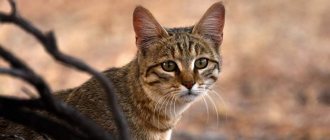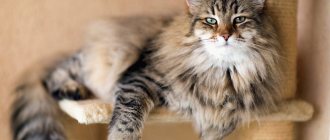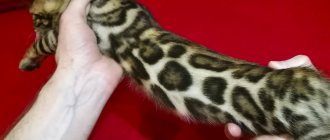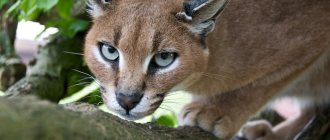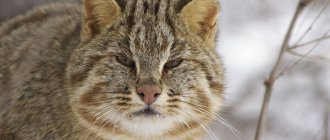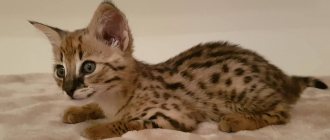There is an opinion that the steppe cat is one of the very first representatives of cats. It is believed that they existed on Earth long before the appearance of man.
They are the ancestors of modern pets. Once upon a time, cats were first domesticated in Ancient Egypt and became sacred there. Steppe cats are otherwise called “savages”. Visually, they resemble domestic cats, but they lead a wild lifestyle, which is why they differ from their counterparts.
Appearance
The wild steppe cat is a subspecies of the wild forest cat. Outwardly they are very similar, but there are also significant differences. They are more like ordinary domestic cats.
Features of the appearance of the steppe cat:
- The animals have a long and muscular body, the length of which can reach 80 centimeters. This is not to say that these are big cats;
- The weight of steppe cats does not exceed 6 kg;
- The animal's paws are strong and strong, of medium length;
- The tail is long and thin, can reach 25 centimeters in length;
- The cat's head is small in size, the muzzle is slightly elongated;
- This cat has large eyes;
- The animal has large ears, with tassels at the tips;
- The animals' fur is short but thick. In winter, the fur remains the same length, which distinguishes it from the forest cat;
- The color of steppe cats is inconspicuous, usually gray or sandy.
In a word, the steppe cat is very easy to confuse with a domestic cat.
Reproduction and care of offspring
What smells do cats not like? 5 Scents That Cats Just Hate
In winter, steppe cats play weddings. Silent animals find their voice. Nature is filled with loud sounds of fighting males. There is no particular difference from domestic relatives. The result of the rut is the pregnancy of a sexually mature female. It takes about two months (56 to 69 days) before giving birth. Most often, 2-3 kittens are born, although 5-6 are also not uncommon. Nature arranges it in such a way that kittens are born when there is a lot of food.
Important! Males show no interest in offspring. The cat is the only one raising them.
Newborn babies are absolutely defenseless. The ability to see and hear appears after a week and a half. They weigh only 35-45 g. The color is the same as that of their parents, only the patterns are clearer. The fur is sparse, not very fluffy. Kittens are kept on pure milk for the first two months. Then the mother begins to teach them to eat meat.
Steppe cat kittens
The training lasts a month. At first, the mother brings killed game, then almost dead, and at the end of training, alive. Three-month-old babies are already hunting with their mother cat. They gain independence by 6 months, more precisely after the change of milk teeth to permanent ones. They reach sexual maturity by the age of one year, but begin to reproduce only at 2 years of age.
Habitat
African wild cat is another name for the animal. This name is closely related to its habitat. Steppe cats live in the vastness of Africa and Asia.
They can also be seen in Russia, but they are found only in the Astrakhan region in semi-desert areas.
They prefer to live near bodies of water where there are thickets and where they can hide to hunt for prey. Open areas are not suitable for the steppe cat. There they can become prey for large predators. Cats also do not like to settle in areas covered with snow because they are visible there.
Features of feeding
Since caracals are predators, for proper development and health they need a balanced diet based on protein. This means that the pet must receive a portion of meat daily - beef, turkey, chicken, rabbit. The quantity varies from 500 g to 1 kg (depending on gender and age).
Some of the meat can be boiled, but the raw product should predominate. There is no need to remove bones and cartilage from the tenderloin. Firstly, they are rich in calcium, which is necessary for development. Secondly, they serve as an excellent “trainer” for the teeth and claws of a predator. It is not recommended to feed your animal soups or cereals. These products do not contain substances beneficial to your pet.
You can diversify your diet with:
- sea fish;
- vegetables (cabbage, pumpkin, carrots, zucchini);
- eggs;
- fermented milk products.
It is advisable to add vitamins and mineral supplements to your food. You should not feed the caracal too fatty or smoked food, pork, or milk.
An adult animal needs 1-2 meals a day. Once a month you need to have a fasting day. Water and food should always be fresh and not too hot or cold.
Lifestyle
The steppe cat is a predator just like a domestic cat. African cats have their own wild characteristics. They prefer to live along the banks of reservoirs and are not at all afraid of water, they can even swim across the river.
But snow is a problem for the African predator; they do not like to hunt on snow cover. Predators also lead a solitary cat-like lifestyle, excluding mating seasons.
Predators spend most of their time in shelters; they can occupy the burrows of foxes, porcupines and other animals, or hide in thickets of bushes.
When encountering a dangerous predator, the cat raises its tail and arches its back, its fur begins to stick out on end. If the enemy continues to attack, she lies on her back and begins to fight him off with all four paws, releasing sharp claws. At the first opportunity, he prefers to run away and hide in a shelter.
The animal's meal is usually small rodents or birds; the predator is not able to hunt larger prey than a hare.
Pallas cat kittens
Reproduction in Pallas cats occurs once a year and they become capable of this at the age of 10 months. The mating season is in February-March. In case of competition, the right to the female goes to the strongest male. Pregnancy of the Pallas cat lasts approximately 2 months, during which time the female sets up a den.
Pallas cat kittens are born in April-May. Typically, 2 to 6 Pallas cat kittens are born. The male does not take part in raising the babies. The Pallas kitten is about 12 cm long and weighs up to 300 grams. Pallas' cat cubs are born blind and absolutely helpless.
The babies begin to see at 10-12 days, the female feeds the cubs with milk and takes care of them. At about 3-4 months they will go hunting for the first time. Pallas cat kittens grow quickly and reach adult size by 6-8 months. The Pallas's cat lives on average 11-12 years.
Wild cat nutrition
The African wild cat prefers to hunt animals such as small rodents, birds, and hares. The diet may also include insects and lizards. The most common rodents eaten are mice, gophers and jerboas.
Among the birds, pheasants and sparrows are distinguished, and they also prefer to hunt domestic chickens. Cats are excellent at climbing trees thanks to their long and sharp claws, climbing into bird nests and happily eating their eggs.
They can eat amphibians, and in water cartilaginous fish become food for the African cat.
Health, life expectancy
Even in the wild, Caracals live up to 13-15 years, and in a cozy home - up to 18-20. They are distinguished by good health and endurance. There are no characteristic hereditary diseases. They only tolerate cold poorly, because their homeland is hot savannahs, steppes and deserts. In the autumn-winter season, reduce the duration of daily walks outside.
At the beginning of life, the pet is given mandatory vaccinations twice:
- 10-12 weeks - polyvalent vaccination (against several diseases at once), after 3 weeks - revaccination;
- 12-13 weeks – rabies vaccination.
Additionally, vaccinations are carried out against panleukemia, rhinotracheitis, and calcevirosis. Do not vaccinate while your pet is sick.
Steppe cats in captivity
It is not difficult to meet a wild animal in a zoo. It should be noted that their life expectancy is low; they rarely live more than 6 years. In zoos, African cats live much longer.
It is believed that the steppe cat is an animal that has no place among people. However, if you start accustoming him to social life from infancy, then it is quite possible to raise an obedient cat.
Steppe cats are wild predators that live in semi-desert areas, often near bodies of water, where there are many thickets and other opportunities for shelter. They feed mainly on small rodents, birds and their eggs.
The most dangerous enemy of an animal is a wild dog. The life expectancy of a steppe cat in the wild is short - about 6 years. You can meet African cats at the zoo and even have a kitten at home.
Mr. Cat explains: who is the Steppe Cat and what subspecies he has
To figure out who the Steppe Cat is, we need to consider the entire species of Felis Silvestris, which in Russian is called Forest, and in English simply Wildcat. This scientific name was given to the species in 1777 by Johann von Schreber, when he first described the European forest cat based on the work of earlier naturalists such as Mathurin Brisson, Ulysses Aldrovandi and Conrad Gessner.
In the 1940s, taxonomist Reginald Innes Pocock examined a collection of skins and skulls of these predators at the Natural History Museum in London and identified subspecies of forest and steppe cats. Hence, all subspecies of Felis Silvestris are conditionally divided into two large groups, namely European forest cats (silvestris) and steppe cats (libyca), which in turn can also be conditionally divided into their own subspecies. More details below.
Silvestris group (forest cats):
- F. s. caucasica (Satunin, 1905) or Caucasian forest cat. Lives in the forests of the Greater and Lesser Caucasus. With the exception of the countries of the former USSR in Turkey (Asia Minor).
- F. s. grampia (Miller, 1907) or Scottish forest cat. As the name implies, it lives in Scotland, in its northern part.
- F. s. silvestris (Schreber, 1777) or Central European forest cat. It lives throughout Europe, but is fragmented, with the exception of Scotland, the Mediterranean islands, and Holland. Also extinct in Austria, but now found there as well due to spread from Italy to the north.
Transitional group silvestris-libyca:
Why transitional? The fact is that previously these subspecies were considered as part of libyca, i.e. steppe cats, and now as part of silvestris, i.e. forest
- F. s. cretensis (Haltenorth, 1953) or Cretan wild cat. Lives exclusively on the island of Crete. The subspecies was considered extinct, but an expedition from the Italian University of Perugia in 1996 managed to catch one individual, which was subsequently released into the wild with a radio transmitter. Later, a nest with kittens was found in the Rouvas forest.
- F. s. jordansi (Schwarz, 1930) or Balearic wild cat. It lives on the Balearic Islands, previously it was believed that on all of them, but now only on Mallorca.
- F. s. reyi (Lavauden, 1929) or Corsican wild cat. Lives on the island of Corsica.
Previously, this entire group was called F. s. sarda (Lataste, 1885). Moreover, at different times only cats living in Sardinia had this name, then in Sardinia and Sicily, and after that all 4: cretensis, jordansi, reyi and sarda.
The libyca group (i.e. the steppe cats themselves), they are further divided into two: ornata-caudata and ornata-libyca.
- ornata-caudata (steppe cats) differs from forest cats in their smaller size, lighter fur color and longer and thinner tails. The domestic cat is thought to have evolved from this group.
- F. s. caudata (Gray, 1874) or Turkestan steppe cat. It lives in Central Asia, Kazakhstan, Eastern Transcaucasia, northern Iran and Afghanistan, southwestern Mongolia and northwestern China. Since the end of the last century it has also been found in Russia.
- F. s. gordoni (Harrison, 1968) or Omani wild cat. Lives on the Arabian Peninsula, Oman and the northeastern part of the UAE. Very small, they easily interbreed with ordinary domestic cats, which leads to the extinction of the subspecies.
- F. s. iraki (Cheesman, 1921). Lives in Kuwait and Sheikh Saad on the Tigris River, Iraq.
- F. s. nesterovi (Birula, 1916). Approximate habitats: Mesopotamia and southern Iran, borders unknown.
- F. s. ornata (Gray, 1832) or Asian steppe (desert) cat. It lives throughout Pakistan, in the western and central parts of India south of the Ganges.
- F. s. tristrami (Pocock, 1944). Lives in Palestine, as well as in the west and south of Arabia.
- ornata-libyca (damn cats). It is distinguished by lighter fur, well-developed dot patterns and stripes.
- F. s. foxi (Pocock, 1944). It lives in western Africa (Paniam plateau, Bauchi province, northern Nigeria).
- F. s. haussa (Thomas and Hinton, 1921). Lives in the Sahara (Chad, Niger, Nigeria, western Sudan (Darfur deserts).
- F. s. cafra (Desmarest, 1822) or South African wild cat. It is found, as the name suggests, in southern Africa.
- F. s. griselda (Thomas, 1926). Habitat: southern Angola, Namibia, Botswana.
- F. s. mellandi (Schwann, 1904). Lives in Central Africa.
F. s. griselda
F. s. mellandi
- F. s. rubida (Schwann, 1904). Lives in Congo.
- F. s. ugandae (Schwann, 1904). It lives in the south of Sudan, Congo, Uganda, Kenya, and Lake Tanganyika.
- F. s. lybica (Forster, 1780) or African steppe cat. Lives in semi-desert regions of northern Africa.
- F. s. ocreata (Gmelin, 1791). Lives in Ethiopia.
Thus, there are 15 subspecies of Steppe cats.
However, now a simplified system is increasingly used, where not groups are considered, but simply subspecies (ornata-caudata is mixed with ornata-libyca):
- F.. s. lybica - African. The species and nominate subspecies have pale, whitish or light grayish fur tinged with red on the spinal stripe, and its pointed tail is about two-thirds the length of the head to the size of the body.
- F. s. cafra - South African. Slightly different in color and pattern from the nominate species. In existing zoological specimens, the skulls are slightly longer than in northern African specimens.
- F. s. ornata - Asian. The animals have dark spots on their light, ocher-gray fur.
- F. s. silvestris - European and transitional. They have dark gray fur with distinct transverse stripes on the sides and a bushy tail with a rounded black tip.
Also often included here are Felis bieti, Chinese mountain cats.
The spotted cat is a member of a family that descended from a common ancestor about 10-15 million years ago. Felis species diverged from it about 6-7 million years ago. The European subspecies formed from 1.09 to 1.4 million years ago.
The direct ancestor of the European forest cat was Felis lunensis, which lived in Europe during the late Pliocene and Villafranchian period. Fossil remains indicate that the transformation from lunensis to silvestris was completed by the Holstein Interglacial Period 320-340 thousand years ago.
Craniological differences between the European and African cats indicate that their ancestor likely migrated during the late Pleistocene from Europe to the Middle East, resulting in a new phenotype.
Features of education
Caracals easily adapt to being kept in captivity and get used to humans. But still, experienced breeders do not recommend buying an animal for families with small children.
With the right approach to education and timely suppression of bad habits, a kitten will grow into a friendly, active and affectionate cat. Education must be quite strict . But physical punishment in dealing with animals is excluded.
If you plan to keep your pet in the house, then you should remove valuables, shoes and clothes, and hide wires in advance. Owners who do not plan to breed animals should consider sterilization. After reaching sexual maturity, animals begin to actively mark their territory and can sometimes show aggression.

